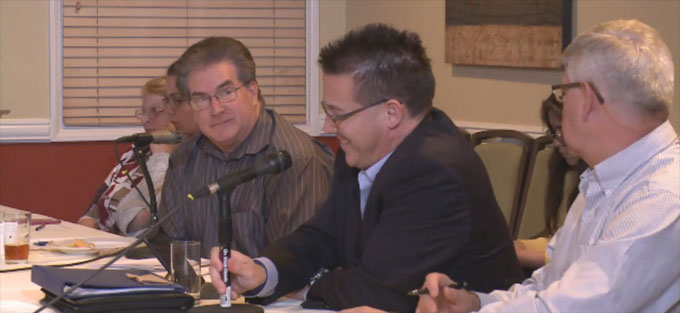
Well by Well Testing Requirements
All Aliso Canyon wells will go through a series of testing before the entire facility may resume gas injections into the field as was announced by the Department of Conservation's Division of Oil, Gas and Geothermal Resources (DOGGR) at the Porter Ranch Community Advisory Committee. The tests were formulated in consultation with technical experts from the Lawrence Berkeley, Lawrence Livermore and Sandia National Laboratories.
All wells will be tested using temperature and noise tests to identify any existing leaks. If any leaks are found, they must be repaired immediately and the tests repeated to confirm success. After a well passes the temperature and noise test, SoCal Gas may choose to continue with the next tests or remove it from operations temporarily.
The next tests are meant to be predictive of potential future leaks. They inspect the casing wall thickness, the bond between the cement casing and the external casing, the shape of the casing. If the well passes these tests, a pressure test is conducted of the inner tubing and then the casing. The pressure will be tested at 115% of the maximum operating pressure, using the extra 15% as the margin of error.
If after the well passes the noise and sound test, SoCal Gas chooses to remove the well from service, they may install a seal at the bottom of the well and fill the well with fluid to exert enough downward pressure against the future pressure of the gas in the field. SoCal Gas then has one year to either remediate the temporarily closed well and have it successfully complete the remaining battery of tests or permanently seal the well with cement.
When all testing is complete and all wells have met the requirements, injection and production will only occur through the inner tubing, not through the casing. Further, all wells injecting gas will be required to:
• Operate with the lowest possible operating pressure
• Have real-time pressure monitors installed that provide immediate notification of pressure change
• Undergo testing of downhole devices very six months
SoCal Gas is currently permitted to withdraw gas from the field for customers.
View a more complete explanation of the testing required
Timing of Well Testing
It could take 20 days to test each well. It may be possible to test ten wells at once. The amount of available qualified personnel, workover rigs and space are the limiting factors. SoCal Gas will decide which wells to test in what order, likely considering their past efficiency and their location in the storage field.
There was discussion about how to communicate to the public the progress on well testing.
Safety Valves
DOGGR is still considering the necessity of requiring safety valves, because sometimes when they are needed, they don’t work. They are seeking public input on safety valves. Please send your comments to: PAO [at] conservation.ca.gov
Qualifications of DOGGR
The CAC questions the effectiveness of DOGGR over time. Jason Marshall, Chief Deputy Director of the Department of Conservation over DOGGR reported that “old DOGGR” used to hide issues from Sacramento and there has been a renewal effort as documented in their Renewal Plan of October 2015. Marshall was brought in to help jumpstart the new DOGGR and the gas leak moved the revision of gas regulations to the top of the list of priorities. All are invited to read the Renewal Plan. Craig Forry, President of Porter Ranch Estates HOA, inquired if Marshall’s role was like a new marshal in town, which generated a welcome chuckle amidst serious discussions. (For the discussion on DOGGR see video at 1:11)
Competency of Aliso Gas Formation
DOGGR answered questions that the geological formation of Aliso Canyon is not leaking. But there could be other sources of methane in the community, including the nearby landfill. (For the discussion on Aliso Canyon Formation see video at 1:08)
SoCal Gas Report
SoCal Gas will now begin to dismantle the rigs associated with the relief wells. They note that each of those rigs is comprised of about 50 truckloads of equipment which we can expect to see traversing Tampa. Coming up Tampa will be workover rigs to complete testing. The workover rigs will be visible from the community, but will not be lit up like other rigs. They will have one light per FAA requirements.
The site of SS25 is secured with a 400 foot radius for investigation by the California PUC. SoCal Gas will work to recondition the pad to allow a workover rig to extract well components for investigation.
Stakeholder Questions
We received quite a few stakeholder questions and while many were answered with the explanation of the testing procedure, we have re-sent the questions to DOGGR to more fully answer outstanding questions.
Complete notes on the meeting: http://www.prcac.com/wp-content/uploads/PRCAC-Meeting-8-notes.pdf
Video of the meeting: https://vimeo.com/155927106.
Regulatory Changes to Gas Storage
The Department of Conservation, Division of Oil, Gas, and Geothermal Resources (Division) is preparing to undertake rulemaking to make significant revisions to the regulations governing the Division’s Gas Storage Program. This rulemaking effort will build upon the requirements adopted by emergency rulemaking to update regulations governing the Gas Storage Program to address concerns identified by the Division and other key stakeholders. The purpose of the attached document is to outline the Division’s immediate regulatory goals, and to solicit specific input on how best to accomplish these goals. Although the Division is looking for any and all input on these questions, suggestions about a specific regulatory approach are most useful if they are supported by discussion of the costs and benefits associated with the approach. Information regarding comment submission can be found in the Pre-Rulemaking Dicussion Document. The Division will be accepting comments until March 18 at 5pm.